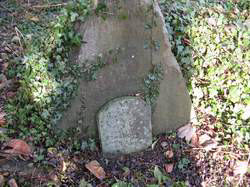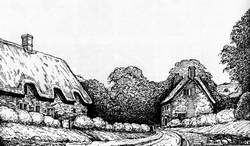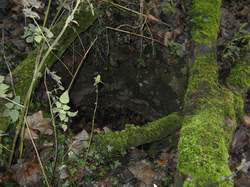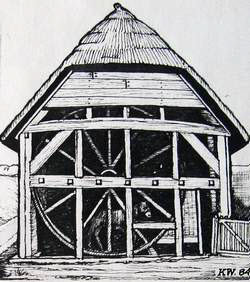Abandoned Communities ..... Snap
The next building (on plot 80) was originally a single cottage, but by 1840 had been converted into two dwellings. One of these cottages may have been reserved for the shepherd as the census records of 1861 and 1871 indicate that its householder was a shepherd. The other cottage was probably the place where a school was run until 1855. The school had been established for 16 pupils in 1812. According to the 1851 census information one of the people living at the cottage in that year was Ann Grant, aged 59, who was listed as a schoolmistress.
The cottage on plot 81 was the smallest in the village, a single storey building with internal dimensions of about 11 by 21 feet. There were two cottages on plot 82. One of these cottages was very close to the bend in the lane. To protect it from passing traffic a large stone was erected in front of it as a kind of bollard. The stone is still there, with a smaller memorial stone now in place in front of it. The dwelling on plot 71 may have been larger, possibly with two floors.
As there was no stream running through the valley the people of Snap had to rely on wells. There was a well some 260 feet deep next to plot 71. Water was brought up from the well by a wheel powered by a pony. The wheel may have had a similar design to a donkey wheel that once existed at Broad Hinton, about eight miles east of Snap.
In 1855 a National School was opened at Woodsend. The school at Snap closed and instead children from the village had to walk up the lane to go to school in Woodsend. The new school building had a single large school room, with two rooms at one end to provide accommodation for the teacher.
Snap was too small to have its own place of worship. Depending on their affiliation the villagers had two options in Woodsend, or else they would have to travel to Aldbourne. After the school opened in 1855 Anglican services were held there on Sundays. But ten years earlier a Methodist chapel had been built in Woodsend. Methodism, of both the Wesleyan and Primitive types, had spread rapidly in Wiltshire between 1825 and 1840. As it was seen as anti-establishment it appealed to members of the working class such as farm workers.
As we have seen already, much interesting information can be gathered from census records. From the records related to Snap it is possible to follow the progress of several individual families from one decade to the next. The Coxhead family, for example, appear in 1841, when the householder John, aged 50, was described as an agricultural labourer. His wife was Mary, aged 45. They had three children aged between 5 and 11, and in addition there was Robert, aged 20, an agricultural labourer, who may have been an older son. Staying with them was Mary Barrett, aged 75. They lived at the house at the eastern end of Snap (on plot 71), sharing it with Joseph Bates and his family.
John Coxhead was not recorded in 1851. Instead the head of household was Mary, now a widow receiving parish relief. Her daughter Eliza, now 21, has married George Coxhead, who must have taken the surname, and they have three children aged between 2 months and 5. One of Mary’s sons, Charles, is also still living with the family. Now 15, his occupation is plough boy.
By 1861 George and Eliza have had two more children and their three older children are still alive. Mary Coxhead, however, is not mentioned. By 1871 the family must have moved away, but others with the same surname appear at later dates, including a Rose Coxhead, aged 22, who was a domestic servant with the Osmond family at the farmhouse in 1901.
In 2005 Ken Watts received a letter from a correspondent in New Zealand telling him that three Coxhead brothers had emigrated from Snap to New Zealand.
The cottage on plot 81 was the smallest in the village, a single storey building with internal dimensions of about 11 by 21 feet. There were two cottages on plot 82. One of these cottages was very close to the bend in the lane. To protect it from passing traffic a large stone was erected in front of it as a kind of bollard. The stone is still there, with a smaller memorial stone now in place in front of it. The dwelling on plot 71 may have been larger, possibly with two floors.
As there was no stream running through the valley the people of Snap had to rely on wells. There was a well some 260 feet deep next to plot 71. Water was brought up from the well by a wheel powered by a pony. The wheel may have had a similar design to a donkey wheel that once existed at Broad Hinton, about eight miles east of Snap.
In 1855 a National School was opened at Woodsend. The school at Snap closed and instead children from the village had to walk up the lane to go to school in Woodsend. The new school building had a single large school room, with two rooms at one end to provide accommodation for the teacher.
Snap was too small to have its own place of worship. Depending on their affiliation the villagers had two options in Woodsend, or else they would have to travel to Aldbourne. After the school opened in 1855 Anglican services were held there on Sundays. But ten years earlier a Methodist chapel had been built in Woodsend. Methodism, of both the Wesleyan and Primitive types, had spread rapidly in Wiltshire between 1825 and 1840. As it was seen as anti-
As we have seen already, much interesting information can be gathered from census records. From the records related to Snap it is possible to follow the progress of several individual families from one decade to the next. The Coxhead family, for example, appear in 1841, when the householder John, aged 50, was described as an agricultural labourer. His wife was Mary, aged 45. They had three children aged between 5 and 11, and in addition there was Robert, aged 20, an agricultural labourer, who may have been an older son. Staying with them was Mary Barrett, aged 75. They lived at the house at the eastern end of Snap (on plot 71), sharing it with Joseph Bates and his family.
John Coxhead was not recorded in 1851. Instead the head of household was Mary, now a widow receiving parish relief. Her daughter Eliza, now 21, has married George Coxhead, who must have taken the surname, and they have three children aged between 2 months and 5. One of Mary’s sons, Charles, is also still living with the family. Now 15, his occupation is plough boy.
By 1861 George and Eliza have had two more children and their three older children are still alive. Mary Coxhead, however, is not mentioned. By 1871 the family must have moved away, but others with the same surname appear at later dates, including a Rose Coxhead, aged 22, who was a domestic servant with the Osmond family at the farmhouse in 1901.
In 2005 Ken Watts received a letter from a correspondent in New Zealand telling him that three Coxhead brothers had emigrated from Snap to New Zealand.
Two
The bollard at the bend in the lane
The cottages at the eastern end of Snap
The village well
The donkey wheel at Broad Hinton
The Methodist chapel at Woodsend. This drawing was done in 1905.




